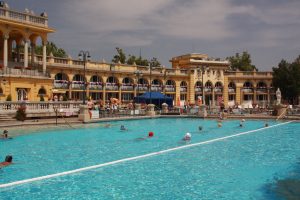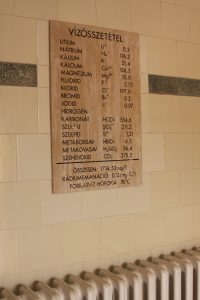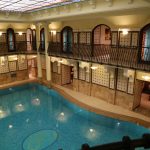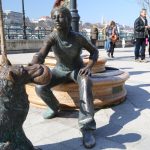 Spa guy John M. Edwards feels frigging fantastic! If you’re in Magyarorstag (Hungary), do as the Daubians do: Say goodbye to “bliss” and splash around au Naturale in the “eau de vie” of a real thermal spa, with a Red Bull in Hand…
Spa guy John M. Edwards feels frigging fantastic! If you’re in Magyarorstag (Hungary), do as the Daubians do: Say goodbye to “bliss” and splash around au Naturale in the “eau de vie” of a real thermal spa, with a Red Bull in Hand…
When you first arrive in Budapest for both (clandestine) “business and pleasure”– feeling like a dumb foreign doppelganger soaking with sweat and stinking of brimstone–say no to the Four Seasons Hotel showers and yes to the Budapest baths–a traditional Hungarian rite of passage, plus a de rigeur destination point to address your addled id directly in a savvy second-person dialogue about what constitutes a real dream vacay.
But first, before you foray forth with your American expat host, an energetic financial writer named Erik D’Amato, who is also the editor of the popular Hungarian-based website pestiside.hu (Erik’s wife, Janet, works for billionaire philanthropist George Soros), you must prepare yourself for authenticated “hedonism” Hungarian-style.
In the illustrious land that gave birth to such Camay-complected beauties as longevity-queen Zsa Zsa Gabor (back in the days when she was in those hot sci-fi Venetian flicks, while her sister, Ava, preferred a Penthouse view to “Green Acres”), everyone seems like they have jumped out of the pages of those heavy “Eurotrash” Design magazines with very little text and an overabundance of adverts. They all seem as poised, relaxed, and healthy as the export versions of Cosmo and GQ Stepford Models. What’s their secret?
An alternative medicine mecca, one in which even gypsy fortune-tellers are taken seriously, Hungary is a little like a colorized Universal Pictures classic, where old world seems new society–and apparatchik chic masquerades as being in line with London, Paris, and Milan. An ethnic paprikash of former equestrian barbarians with DNA from the sere steppes and depopulated puzta, hungry Hungarians are big on fine food and drink (by far the best in Central Europe), and enjoying life to its outer limits. More important, they have something other major European cities don’t have: natural thermal springs!
So at Erik’s suggestion, you fortify your resolve at one of the city’s many wine bars, feeling a little like an extra from “Twilight,” sucking down glasses of strong blood-colored Bull’s Blood of Egri (cheap) and Soprani Kekfrankos (pricey). Even the Hungarian/Romanian ruler Vlad Tepes (“Vlad the Impaler”), the historical Count Dracula, would approve of such neocapitalist decadence.
Then you wend your way towards the baths, walking slowly like a consumptive sleepwalker at a 19th-century-novel sanitorium, or an aging movie star hopeful of being recognized on passegiata, while Erik points out some bulletholes on a building dating back to the failed 1956 Hungarian Uprising against the Soviets.
Stifled during the Cold War, the signature baths for years were hidden behind the iron shower curtain, reserved mostly for local talent and busloads of East Bloc communist tourists, manned by Soviet satellite staffs with brusque Brezhnevian manners. But now that Budapest is an epicenter of elegantly handled mass tourism—a real nightlife hotspot and bonafide boho mecca–the thermal waltzy waters are full of overseas vacationers, businessmen, backpackers, and expats.
Instead of gossiping at Starbucks, Hungarians socialize in the baths buck naked, with the hypnotic gurgle of their “secret” Finno-Ugric language mingling with the sound of bubbling moving water. With so many people bobbing up and down in bathing caps, like Olympic Water Poloists with Michael-Phelps-like physiques, your average American Joe might feel like he has been plunked into a gigantic pot of boiling eggs.
The ancient baths of Budapest date back to Roman times, when the city was known as “Acquincum”: for the natural thermal mineral waters that flowed like prized Pellegrino from the limestone rocks of the Buda hills. But it wasn’t until the Ottomans came and conquered in circa 1541 that Turkish-style bathhouses were built throughout the city. One of the most architecturally “Oriental” watering troughs is the remarkably surreal Rudas Baths, whose neo-Asiatic dome allows streaks of sickle-sliced sunlight in the film-noir steam.
Buda has around 120 thermal springs, which feed into gyogyfurdo (mineral baths) in such places as the Kiraly Baths, with its 16th-century pool, the Rac Baths, with its Turkish octagonal pool, and the mixed-sex Lukacs Baths, with its two outdoor swimming pools (tanning central) and thermal baths. But perhaps the best baths for Afar readers, intrepid tourists, and business travelers with briefcases bulging with rubberband-bound Franklins is the mixed-sex Szechenyi Baths (a.k.a., “Chain Baths”), a popular meeting place (read: pickup spot) with a series of outdoor swimming pools and thermal pools, indoor thermal baths and steam rooms, and a retro restaurant, resembling a hip commie cafeteria (budget space age), serving much more than just over-paprikaed goulash. It’s one of the largest health spas in Europe.
All Budapest facilities have steam rooms and saunas (invented by the Hungarians’ ethnic brethren, the Finns) in addition to plunge pools of varying temperature. The tonic waters are reputed to have Ponce-de-Leon-like anti-aging and rejuvenation properties. At least, M.D.s agree the warm waters are perfect for treating chronic arthritis and muscle and nerve pain. So float on the waters and dream away, while ridding yourself of pernicious road rigors.
After you arrive at Budapest’s most famous soaking station, the Gellert Baths, which date back to the 13th century, get a gander at the magnificent Art Nouveau interior. After a small fee in forints (or euros, no big whoop), you enter through a side entrance, then wander through a labyrinthine rabbit warren of corridors, shower stalls, steam areas, and saunas until you reach the changing rooms.
 Thus with some trepidation you finally doff your clothes and emerge in your too-tight Speedo briefs. (Some daredevils sport supplied loincloths or do without.) Europeans are no prudes, so being starkers among complete strangers takes some getting used to for the puritanical, practical readers of The New York Times Sunday Travel Section. The separate thermal pools—one entrance for men, one entrance for women—lead from the stately main 33-meter swimming pool at the far end. The atmosphere: Habsburg opulence.
Thus with some trepidation you finally doff your clothes and emerge in your too-tight Speedo briefs. (Some daredevils sport supplied loincloths or do without.) Europeans are no prudes, so being starkers among complete strangers takes some getting used to for the puritanical, practical readers of The New York Times Sunday Travel Section. The separate thermal pools—one entrance for men, one entrance for women—lead from the stately main 33-meter swimming pool at the far end. The atmosphere: Habsburg opulence.
One warning: finding the facilities (WC = water closet = bathroom), especially after having polished off a peppery paprikash in the recent past, can soon turn into Hungarian Folk Dance Number 2 (pun intended).
Once you’re waterlogged and wallowing in dancing dolphin endorphins, you can dry off your goosepimples by the glorious banks of the Blue Danube (with its strange deja-vu delusion that you are in a more-perfect, mirror-image version of Manhattan/Brooklyn with it’s crisscrossing iron bridges joining Buda and Pest). Hence, it’s high time to hail a taxi to a ubiquitous Grand Tour staple: The fin de siecle “Grand Café.” You decide on and arrive at the world-famous Café Gerbeaud (V. Vorosmarty ter 7; Tel. 118-0892), built in 1870, to continue your spa treatment. The Hunger.
Hunkering down with the Hungarian elite like a skilled flaneur for some Austro-Hungarian-style pastries and thick Vienna-style brew, you watch a circus menagerie of what you imagine are opera singers, embassy spies, noble baron vintners, and buffoonish burgomeisters wearing obsolete fedoras from the small-town equivalents of Central European Appalachia: “Transylvania”! This evocative castle-crazy riddle–which Hungarians say makes a good sidetrip (whoa!: precipitous mountain passes with no railings and sheer drops)–is still a sore point between sorta-Germanic Hungary and their more Italianate rivals, the Romanians, who gobbled up this little geopolitical wedge of Linzer Torte landscape after World War II.
Oh well. Why not?—a little Tokaj to seal the deal with the day, if not with the Devil Himself. And isn’t that fab Franz Lizt lazily drifting through the airwaves from hidden speakers, which may have once been used to bug the conversations of counterrevolutionaries and foreign kaffe- klatchers? “Igen” (Yes), not a bad way to begin a trip to Budapest, brimming with butterflies of anticipation, and completely relaxed and without a care in the world. . . .
Except perhaps when the “luxus” bill arrives. Its pulse-pounding sum is as alarming as a Mozartian Turk whirling past Budapest to storm nearby Vienna (another good sidetrip), the Empire’s former capital. The expulsion of what Erik humorously calls these “Asiatic savages,” with a smile of reptilian mirth, from this now mostly Christian country is still celebrated to this day by the invention of the symbolic crescent-shaped “croissant.”
“Kursonem” (thank you: sounds like “curse on him”). I guess the markup, during a worldwide economic crisis, means Hungarians are proud of their fast forward lunge from “emerging market” into the European Union (nevermind NATO), when it’s now high time to cash in, play catchup. At any rate, the Old World waiter corpse, with a starched apron, eerie handlebar mustache, and “servis compris” scowl–reminiscent of both creepy Hungarian actors Bela Lugosi and Peter Lorre–waits patiently as you lugubriously count out the change, clutching a Red Bull.
Zounds!
Next time, please just put it all on your Platinum Card.
Budapest’s Finest Fountains of Youth
Gellert Gyogyfurdo
XI. Kelenhegyi ut 4; Tel. 166-6166
6 a.m.-6 p.m. daily (mixed)
Kiraly Gyogyfurdo
II. Fo utca; Tel. 201-4392
6:30 a.m.-7 p.m., Mon., Wed., Fri.
(men); Tue., Thur., Sat. (women)
Rac Gyogyfurdo
I. Hadnagy utca 8-10; Tel. 356-1010
6 a.m.-6 p.m., Tue., Thur., Sat. (men);
Mon., Wed., Fri. (women)
Rudas Gyogyfurdo
I. Dobrentei ter 9; Tel. 356-1322
6 a.m.-7 p.m., Mon.-Fri.; 6 a.m.-1 p.m.
Sat., Closed Sun. (men only)
Lukacs Gyogyfurdo
II. Frankel Leo ut 25-29; Tel. 326-1695;
6 a.m.-7 p.m., Mon.-Sat.; 6 a.m.-5 p.m.
Sun. (mixed)
Szechenyi Gyogyfurdo
XIV. Allatkerti korut 11: Tel.121-0310
6 a.m.-7 p.m. daily (mixed)





Magyarorszag and not ‘Magyarorstag’.